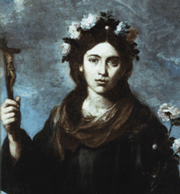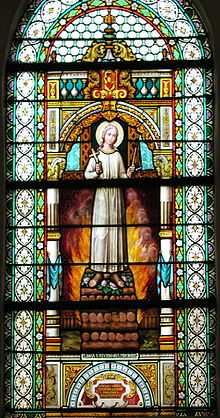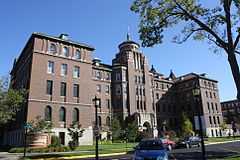Rose of Viterbo
| St. Rose of Viterbo, T.O.S.F. | |
|---|---|
 | |
| Virgin and recluse | |
| Born |
c. 1233 Viterbo, Papal States |
| Died |
March 6, 1251 Viterbo, Papal States |
| Honored in |
Roman Catholic Church (Third Order of St. Francis and Viterbo, Italy) |
| Canonized | 1457 by Pope Callistus III |
| Major shrine |
Church of St. Rose Viterbo, Italy |
| Feast | 4 September |
| Attributes | A young woman with a crown of roses, holding a crucifix |
| Patronage | people in exile; people rejected by religious orders; Franciscan youth; Viterbo, Italy |
Rose of Viterbo, T.O.S.F. (c. 1233 – March 6, 1251), was a young woman born in Viterbo, then a contested commune of the Papal States. She spent her brief life as a recluse, who was outspoken in her support of the papacy. Otherwise leading an unremarkable life, she later became known for her mystical gifts of foretelling the future and having miraculous powers. She is honored as a saint by the Catholic Church.
Life
The chronology of her life remains uncertain, as the acts of her canonization, the chief historical sources, record no dates.[1] Most scholars agree she was probably born around the year 1233.[2]
Born of poor and pious parents, even as a child Rose had a great desire to pray and to aid the poor.<ref name=foley /[3] When but three years old, she allegedly raised to life her maternal aunt.<ref name=habig /[4] At the age of seven, she had already lived the life of a recluse, devoting herself to penances. She prayed much for the conversion of sinners.[5] Rose was not yet 10 years old when the Blessed Virgin Mary is reputed to have instructed her to enroll herself in the Third Order of St. Francis and to preach penance to Viterbo, at that time held by Frederick II, Holy Roman Emperor.[1]

Rose was soon admitted to the Franciscan Third Order and adopted its religious habit, a simple tunic with a cord around her waist. While walking the streets with a crucifix in her hand, she would exhort others to be faithful to the Catholic Church.[2]
Rose attempted at age 15 to found a monastery. The effort failed and she returned to a life of prayer, penance and solitude in her father's home.
Every now and then she would emerge from her solitude to entreat the people to do penance.[5] Her mission seems to have lasted for about two years. In January 1250, Viterbo, her native city, was then in revolt against the pope. When Rose took the pope’s side against the emperor, she and her family were exiled from the city and took refuge in Soriano nel Cimino. When the pope’s side won in Viterbo, Rose was allowed to return.[6]
On December 5, 1250, Rose allegedly foretold the speedy death of the emperor, a prophecy realized on December 13. Soon afterwards she went to Vitorchiano, whose inhabitants, according to surviving reports, were affected by a supposed sorceress. Rose secured the conversion of all, even of the sorceress, reportedly by standing unscathed for three hours in the flames of a burning pyre.[1]
Rose wished to enter the Poor Clare Monastery of St. Mary in the city, but was refused because of her poverty, as she was not able to provide the dowry required for admission. She accepted her rejection, nonetheless foretelling her admission to the monastery after her death.
Rose died on March 6, 1251, in her father’s home.[6] It was long believed that Rose had died of tuberculosis. In 2010, however, researchers examining her remains concluded that she had died of a heart condition called Cantrell's syndrome.[7]
Veneration

The process of Rose's canonization was opened in the year of her death by Pope Innocent IV, but was not definitively undertaken until 1457. Originally buried at the parish church of Santa Maria in Poggio, in 1257 Pope Alexander IV ordered it moved to the monastery she had desired to enter, at which time it was renamed in her honor.[8]
When the liturgical calendar of the Roman Catholic Church was reformed after the Second Vatican Council, her feast day was transferred to the date of her death. September 4 is the date of the translation of her relics to the Monastery of St. Damian. It is this latter date on which her feast is celebrated in Viterbo and by the Franciscans.
On September 3, the eve of the feast of St. Rose, the people of Viterbo follow the transportation of La Macchina (the Machine of St. Rose” ) a massive 28 metre high tower, illuminated with 3,000 tiny electric lights and 880 candles, and topped off with a statue of her, which is carried for 1,200 metres through the darkened streets of the old medieval town on the backs of around 100 volunteers called “facchini.” The tradition goes all the way back to September 4, 1258, when the body of the saint was exhumed and transported to the Monastery of Saint Damian; but it was not until 1664, following seven years of plague in the city, that a “machine” first appeared. In gratitude for having survived such a terrible pestilence the citizens voted to renew the veneration of their saint every year.[9]

St. Rose of Viterbo Convent, named for her, in La Crosse, Wisconsin, is the motherhouse of the Franciscan Sisters of Perpetual Adoration.[10] The convent is listed on the National Register of Historic Places.
Viterbo University is a Catholic, Franciscan university in the liberal arts tradition, founded by these Franciscan Sisters, also located in La Crosse, Wisconsin.[2]
Rose of Viterbo is one of the religious figures featured in the award-winning series of saint plays by Erik Ehn. The play celebrating her life premiered in October 2008 at Goshen College.
Notes
- ↑ 1.0 1.1 1.2 Cleary, Gregory. "St. Rose of Viterbo." The Catholic Encyclopedia. Vol. 13. New York: Robert Appleton Company, 1912. 5 Mar. 2013
- ↑ 2.0 2.1 2.2 Viterbo University
- ↑ Foley, Leonard, O.F.M.; McCloskey, Pat, O.F.M., rev. "St. Rose of Viterbo". Saint of the Day, Lives, Lessons, and Feast (Franciscan Media). ISBN 978-0-86716-887-7.
- ↑ Habig, Marion, O.F.M., ed. (1959). The Franciscan Book of Saints. Franciscan Herald Press.
- ↑ 5.0 5.1
- ↑ 6.0 6.1
- ↑ D'Anastasio PhD, Ruggero et al. (19 June 2010). "The Heart of Santa Rosa". The Lancet 375 (9732): 2168.
- ↑ "Il Monastero". Monastero Sanctuario Clarisse di Santa Rosa.(Italian)
- ↑ The "Machine" of St. Rose of Viterbo", August 24, 2009
- ↑ Franciscan Sisters of Perpetual Adoration
Sources
- De Kerval, Ste Rose, sa vie et son temps (Vanves, 1896);
- Pizzi, Storia della Città di Viterbo (Rome, 1887).
External links
| Wikimedia Commons has media related to Rose of Viterbo. |